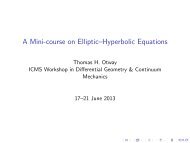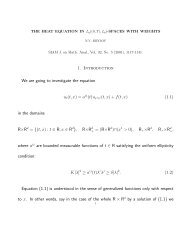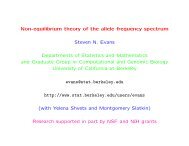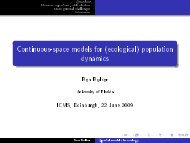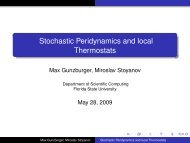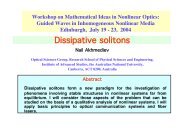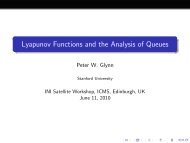Luc TARTAR Compensated Compactness with more ... - ICMS
Luc TARTAR Compensated Compactness with more ... - ICMS
Luc TARTAR Compensated Compactness with more ... - ICMS
Create successful ePaper yourself
Turn your PDF publications into a flip-book with our unique Google optimized e-Paper software.
I was puzzled that they considered a not so realistic EOS (equation<br />
of state), since incompressibility implies an infinite speed<br />
of sound, <strong>with</strong>out saying what to do for a realistic situation,<br />
of a (compressible) fluid occupying a domain Ω ⊂ R 3 having a<br />
boundary (while compact manifolds have no boundary)!<br />
Thirty years after I was again puzzled that for writing the<br />
questions for the million dollar Clay Prize on Navier–Stokes<br />
equation, Charles FEFFERMAN could not find (in Princeton<br />
or elsewhere) a knowledgeable person (mathematician or not)<br />
who could tell him what the equation is about: he should have<br />
mentioned the basic conservation laws of Continuum Mechanics<br />
and explained why he did not use the conservation of energy;<br />
among the groups of invariance of the equation he should have<br />
mentioned the invariance by rotation (since one considers an<br />
isotropic fluid) and Galilean invariance; in selecting cases <strong>with</strong>out<br />
boundary (R 3 or a flat torus) he should have mentioned<br />
that realistic domains have a boundary, and because bounding<br />
the vorticity is the main difficulty for proving global existence<br />
of smooth solutions, he should have mentioned the importance<br />
of the boundary, since it seems that vorticity is created there.<br />
In 1970, I first read about covariant derivatives, used for writing<br />
Navier–Stokes equation on a Riemannian manifold, but<br />
later I wondered why geometers think it is a good way to<br />
write such equations: is their framework useful for <strong>more</strong> general<br />
EOS For example, realistic fluids have their viscosity depending<br />
upon temperature, maybe also upon pressure.<br />
Geometers (and later harmonic analysts) seemed to think that<br />
they were doing a useful job in writing equations of Continuum<br />
Mechanics in their language, but has it led to a natural way of<br />
obtaining a priori estimates for flows of realistic fluids<br />
4




